Tire Acura TSX 2011 Service Manual
[x] Cancel search | Manufacturer: ACURA, Model Year: 2011, Model line: TSX, Model: Acura TSX 2011Pages: 324, PDF Size: 7.85 MB
Page 279 of 324
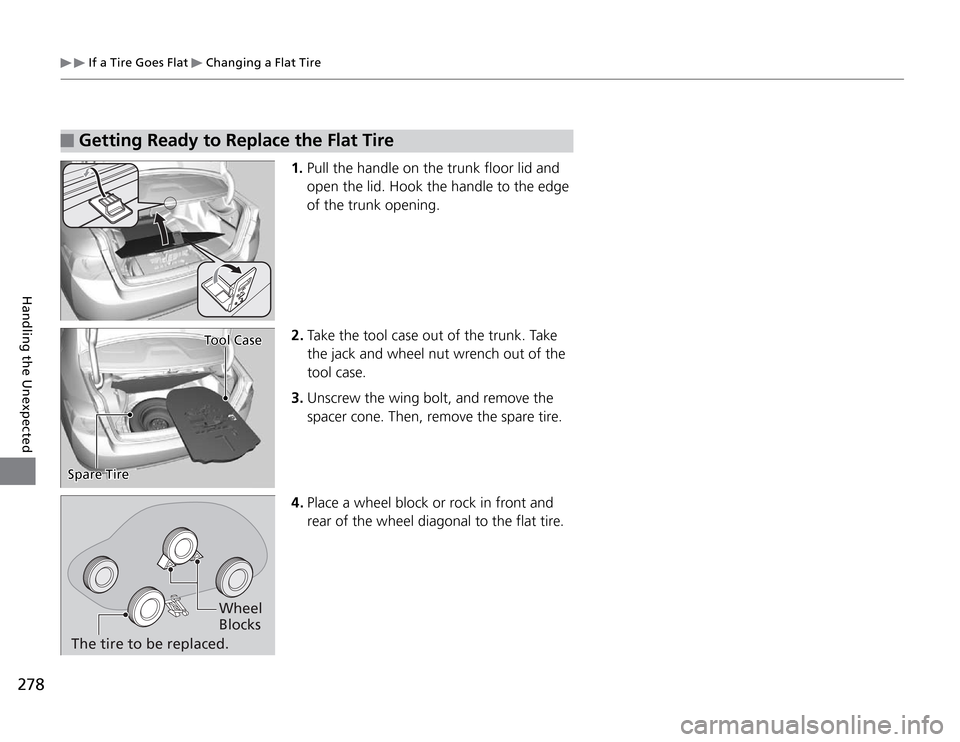
If a Tire Goes Flat
Changing a Flat Tire
278Handling the Unexpected
2. Take the tool case out of the trunk. Take
the jack and wheel nut wrench out of the
tool case.
3. Unscrew the wing bolt, and remove the
spacer cone. Then, remove the spare tire. 1. Pull the handle on the trunk floor lid and
open the lid. Hook the handle to the edge
of the trunk opening.
Getting Ready to Replace the Flat Tire
4. Place a wheel block or rock in front and
rear of the wheel diagonal to the flat tire.
The tire to be replaced.
Wheel
Blocks
Tool Case
Spare Tire
Page 280 of 324
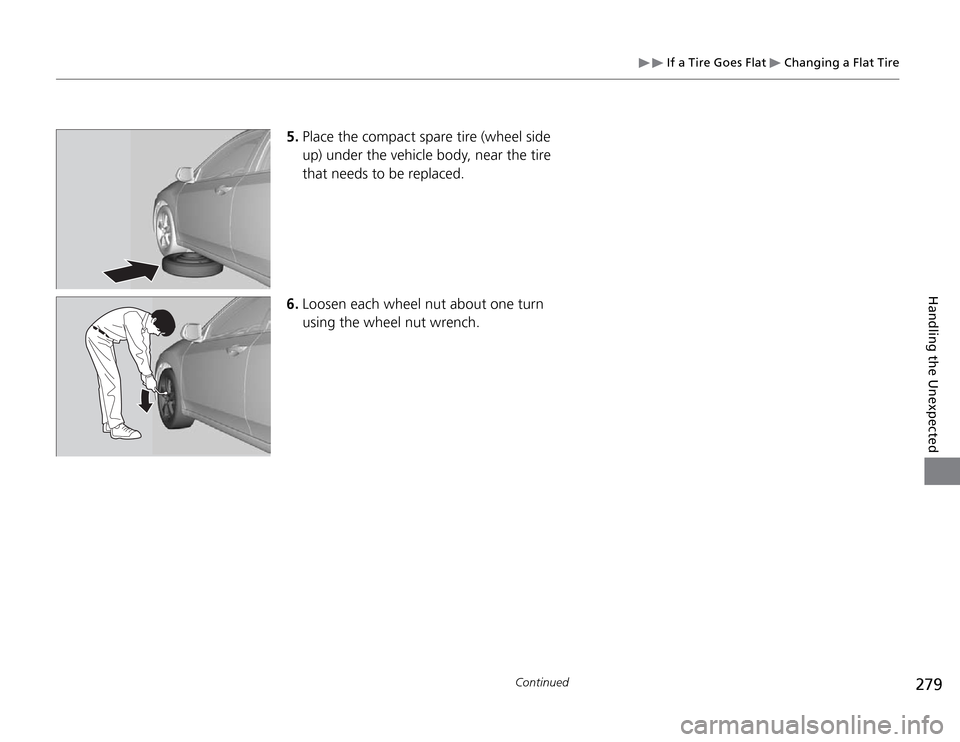
If a Tire Goes Flat
Changing a Flat Tire
279
Continued
Handling the Unexpected
6. Loosen each wheel nut about one turn
using the wheel nut wrench. 5. Place the compact spare tire (wheel side
up) under the vehicle body, near the tire
that needs to be replaced.
Page 281 of 324
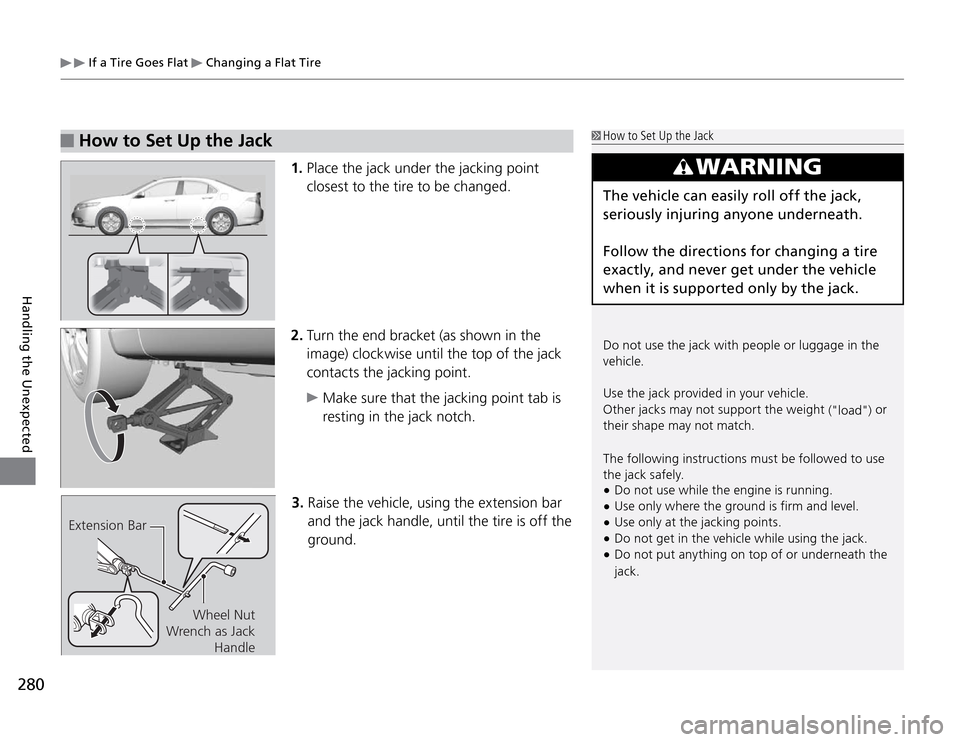
If a Tire Goes Flat
Changing a Flat Tire
280Handling the Unexpected
WARNING
The vehicle can easily roll off the jack,
seriously injuring anyone underneath.
Follow the directions for changing a tire
exactly, and never get under the vehicle
when it is supported only by the jack.
How to Set Up the Jack
How to Set Up the Jack
Do not use the jack with people or luggage in the
vehicle.
Use the jack provided in your vehicle.
Other jacks may not support the weight
("load") or
their shape may not match.
The following instructions must be followed to use
the jack safely.
Do not use while the engine is running. �tUse only where the ground is firm and level. �tUse only at the jacking points. �tDo not get in the vehicle while using the jack. �tDo not put anything on top of or underneath the �tjack.
1. Place the jack under the jacking point
closest to the tire to be changed.
2. Turn the end bracket (as shown in the
image) clockwise until the top of the jack
contacts the jacking point.
Make sure that the jacking point tab is
resting in the jack notch.
3. Raise the vehicle, using the extension bar
and the jack handle, until the tire is off the
ground.
Extension Bar
Wheel Nut
Wrench as Jack
Handle
Page 282 of 324

If a Tire Goes Flat
Changing a Flat Tire
281
Continued
Handling the Unexpected
Replacing the Flat Tire
1. Remove the wheel nuts and flat tire.2. Wipe the mounting surfaces of the wheel
with a clean cloth.
3. Mount the compact spare tire.
4. Screw the wheel nuts until they touch the
lips around the mounting holes, and stop
rotating.
5. Lower the vehicle and remove the jack.
Tighten the wheel nuts in the order
indicated in the image. Go around,
tightening the nuts, two to three times in
this order.
Wheel nut torque:
80 lbf∙ft (108 N∙m, 11 kgf∙m)
Replacing the Flat Tire
Do not over tighten the wheel nuts by applying
extra torque using your foot or a pipe.
Page 283 of 324
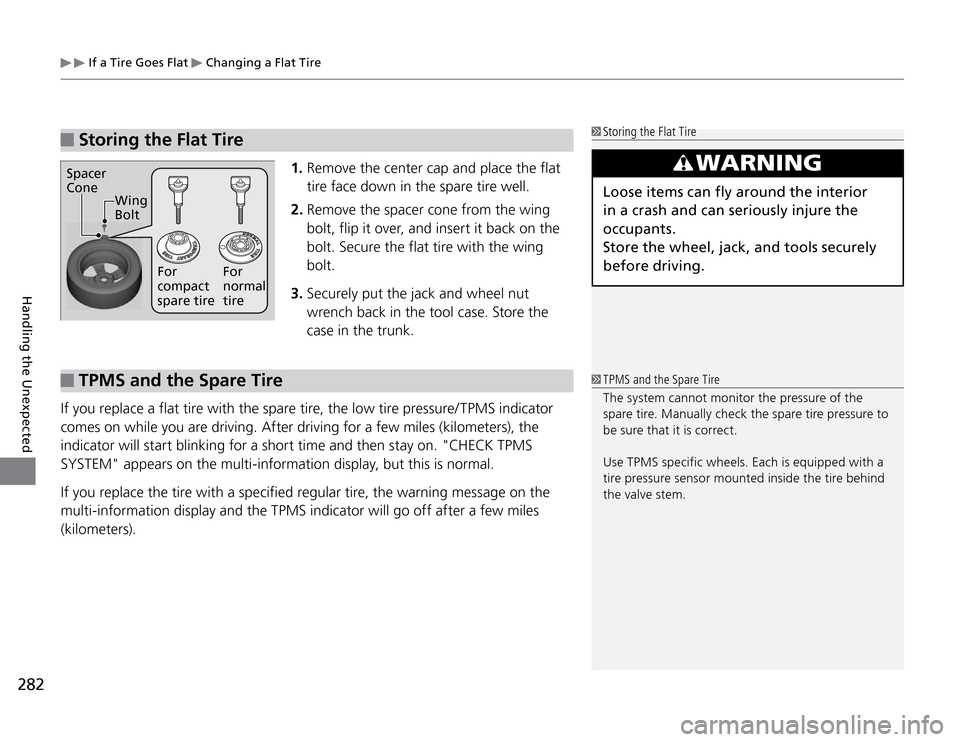
If a Tire Goes Flat
Changing a Flat Tire
282Handling the Unexpected
WARNING
Loose items can fly around the interior
in a crash and can seriously injure the
occupants.
Store the wheel, jack, and tools securely
before driving.
Storing the Flat Tire
1. Remove the center cap and place the flat
tire face down in the spare tire well.
2. Remove the spacer cone from the wing
bolt, flip it over, and insert it back on the
bolt. Secure the flat tire with the wing
bolt.
3. Securely put the jack and wheel nut
wrench back in the tool case. Store the
case in the trunk.
Storing the Flat Tire
TPMS and the Spare Tire
If you replace a flat tire with the spare tire, the low tire pressure/ TPMS indicator
comes on while you are driving. After driving for a few miles (kilometers), the
indicator will start blinking for a short time and then stay on. "CHECK TPMS
SYSTEM" appears on the multi-information display, but this is normal.
If you replace the tire with a specified regular tire, the warning message on the
multi-information display and the TPMS indicator will go off after a few miles
(kilometers).
TPMS and the Spare Tire
The system cannot monitor the pressure of the
spare tire. Manually check the spare tire pressure to
be sure that it is correct.
Use TPMS specific wheels. Each is equipped with a
tire pressure sensor mounted inside the tire behind
the valve stem.
Wing
Bolt
For
normal
tire For
compact
spare tire Spacer
Cone
Page 294 of 324
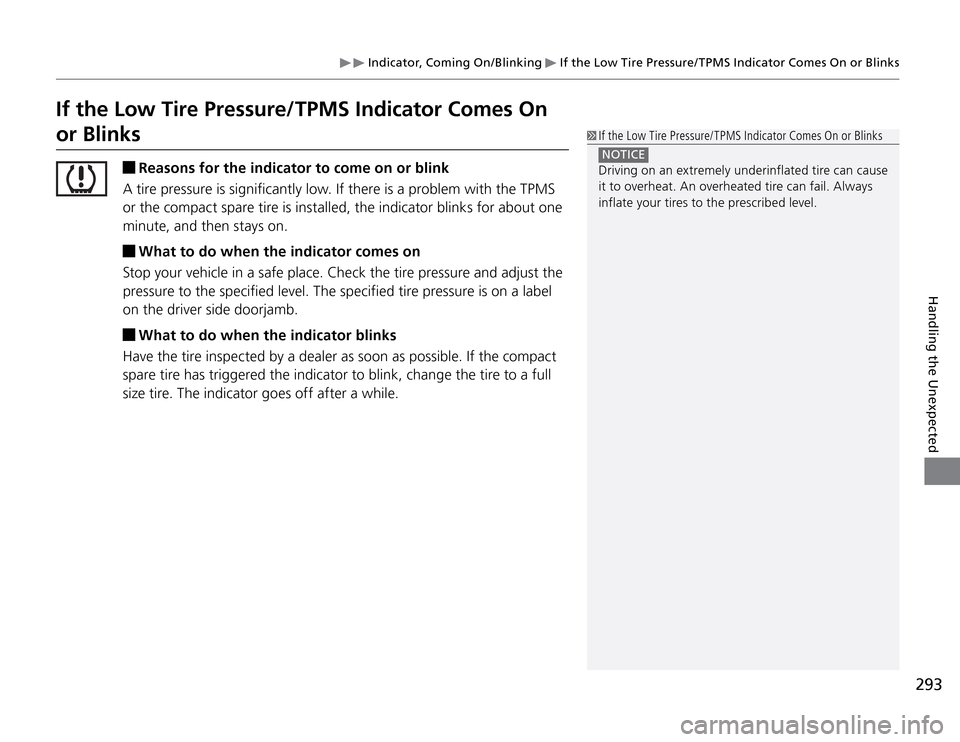
Indicator, Coming On/Blinking
If the Low Tire Pressure/ TPMS Indicator Comes On or Blinks
293
Handling the Unexpected
Reasons for the indicator to come on or blink
A tire pressure is significantly low. If there is a problem with the TPMS
or the compact spare tire is installed, the indicator blinks for about one
minute, and then stays on. What to do when the indicator comes on
Stop your vehicle in a safe place. Check the tire pressure and adjust the
pressure to the specified level. The specified tire pressure is on a label
on the driver side doorjamb. What to do when the indicator blinks
Have the tire inspected by a dealer as soon as possible. If the compact
spare tire has triggered the indicator to blink, change the tire to a full
size tire. The indicator goes off after a while.
If the Low Tire Pressure/ TPMS Indicator Comes On or Blinks NOTICE Driving on an extremely underinflated tire can cause
it to overheat. An overheated tire can fail. Always
inflate your tires to the prescribed level.
If the Low Tire Pressure/TPMS Indicator Comes On
or Blinks
Page 299 of 324

Emergency Towing
298Handling the Unexpected
Call a professional towing service if you need to tow your vehicle.
Flat bed equipment
The operator loads your vehicle on the back of a truck.
This is the best way to transport your vehicle. Wheel lift equipment
The tow truck uses two pivoting arms that go under the front tires and lift them
off the ground. The rear tires remain on the ground. This is an acceptable way
to tow your vehicle.
Emergency Towing NOTICE Trying to lift or tow your vehicle by the bumpers
will cause serious damage. The bumpers are not
designed to support the vehicle's weight. NOTICE Improper towing such as towing behind a
motorhome or other motor vehicle can damage the
transmission.
Never tow your vehicle with just a rope or chain.
It is very dangerous, since ropes or chains may shift
from side to side or break.
Page 304 of 324
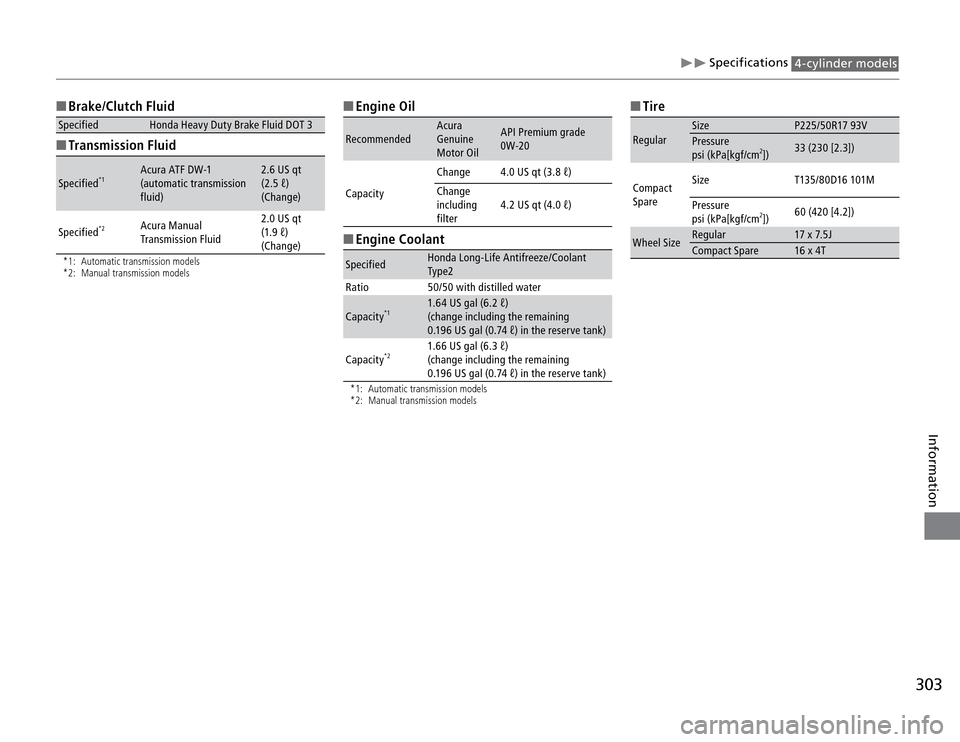
303
Information
Specifications
4-cylinder models
�O Brake/Clutch FluidSpecified Honda Heavy Duty Brake Fluid DOT 3�O Transmission FluidSpecified
*1
Acura ATF DW-1
(automatic transmission
fluid)2.6 US qt
(2.5 ℓ)
(Change)
Specified
*2
Acura Manual
Transmission Fluid2.0 US qt
(1.9 ℓ)
(Change)
*1: Automatic transmission models
*2: Manual transmission models
�O Engine OilRecommendedAcura
Genuine
Motor OilAPI Premium grade
0W-20
CapacityChange 4.0 US qt (3.8 ℓ)
Change
including
filter4.2 US qt (4.0 ℓ)�O Engine CoolantSpecifiedHonda Long-Life Antifreeze/Coolant
Ty pe2
Ratio 50/50 with distilled water
Capacity
*1
1.64 US gal (6.2 ℓ)
(change including the remaining
0.196 US gal (0.74 ℓ) in the reserve tank)
Capacity
*2
1.66 US gal (6.3 ℓ)
(change including the remaining
0.196 US gal (0.74 ℓ) in the reserve tank)
*1: Automatic transmission models
*2: Manual transmission models
�O TireRegularSize P225/50R17 93V
Pressure
psi (kPa[kgf/cm
2])33 (230 [2.3])
Compact
SpareSize T135/80D16 101M
Pressure
psi (kPa[kgf/cm2])60 (420 [4.2])
Wheel SizeRegular 17 x 7.5J
Compact Spare 16 x 4T
Page 306 of 324
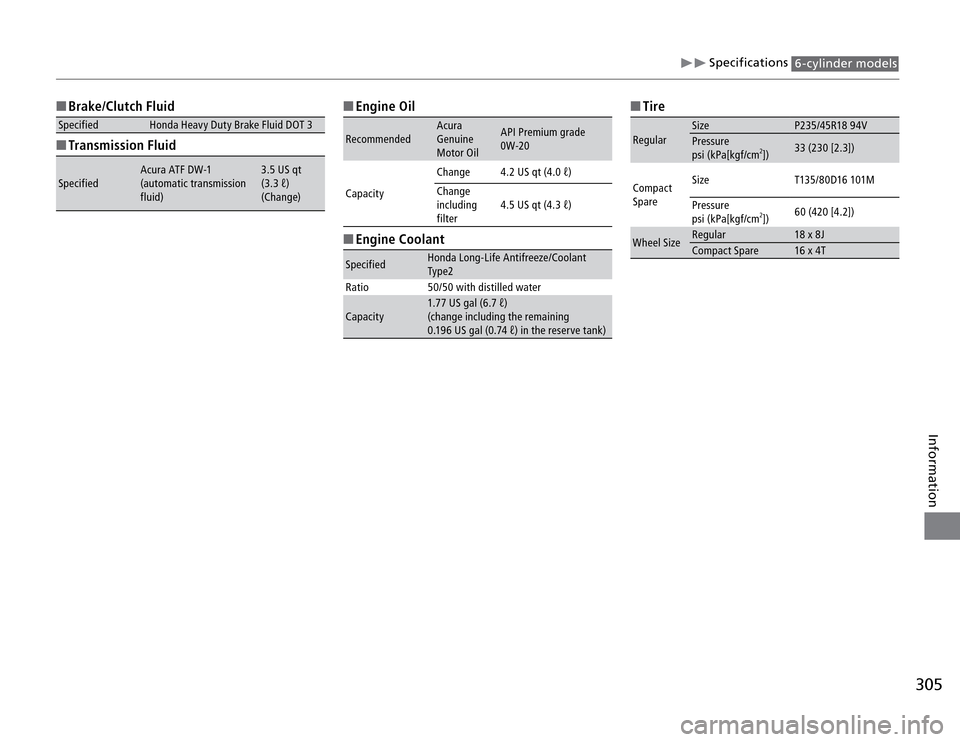
305
Information
Specifications
6-cylinder models
�O Brake/Clutch FluidSpecified Honda Heavy Duty Brake Fluid DOT 3�O Transmission FluidSpecifiedAcura ATF DW-1
(automatic transmission
fluid)3.5 US qt
(3.3 ℓ)
(Change)
�O Engine OilRecommendedAcura
Genuine
Motor OilAPI Premium grade
0W-20
CapacityChange 4.2 US qt (4.0 ℓ)
Change
including
filter4.5 US qt (4.3 ℓ)�O Engine CoolantSpecifiedHonda Long-Life Antifreeze/Coolant
Ty pe2
Ratio 50/50 with distilled water
Capacity1.77 US gal (6.7 ℓ)
(change including the remaining
0.196 US gal (0.74 ℓ) in the reserve tank)
�O TireRegularSize P235/45R18 94V
Pressure
psi (kPa[kgf/cm
2])33 (230 [2.3])
Compact
SpareSize T135/80D16 101M
Pressure
psi (kPa[kgf/cm2])60 (420 [4.2])
Wheel SizeRegular 18 x 8J
Compact Spare 16 x 4T
Page 308 of 324

307
Devices that Emit Radio Waves
Information
The following products and systems on your vehicle emit radio waves when in
operation.
AcuraLink (U.S. models only) Audio System
Bluetooth
® AudioBluetooth
® HandsFreeLink
®
HomeLink
®Universal Transceiver
Immobilizer System
Remote Transmitter
Tire Pressure Monitoring System (TPMS)
Each of the above complies with the appropriate requirements or the required
standards of FCC (Federal Communication Communision) and Industry Canada
Standard, described below:As required by the FCC:
This device complies with Part 15 of the FCC rules. Operation is subject
to the following two conditions: (1) This device may not cause harmful
interference, and (2) this device must accept any interference received,
including interference that may cause undesired operation.
Changes or modifications not expressly approved by the party responsible
for compliance could void the user's authority to operate the equipment.
This device complies with Industry Canada Standard RSS-210. Operation
is subject to the following two conditions: (1) this device may not cause
interference, and (2) this device must accept any interference that may
cause undesired operation of the device.